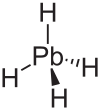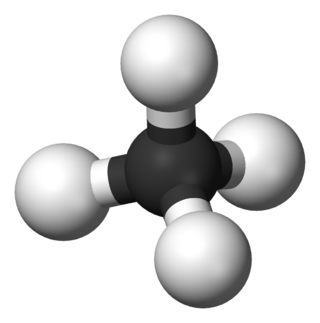Group 14 hydrides are chemical compounds composed of hydrogen atoms and group 14 atoms (the elements of group 14 are carbon, silicon, germanium, tin, lead and flerovium).
Group 14 hydrides are chemical compounds composed of hydrogen atoms and group 14 atoms (the elements of group 14 are carbon, silicon, germanium, tin, lead and flerovium).
The tetrahydride series has the chemical formula XH4, with X representing any of the carbon family. Methane is commonly the result of the decomposition of organic matter and is a greenhouse gas. The other hydrides are generally unstable, poisonous metal hydrides.
They take on a pyramidal structure, and as such are not polar molecules like the other p-block hydrides.
Unlike other light hydrides such as ammonia, water and hydrogen fluoride, methane does not exhibit any anomalous effects attributed to hydrogen bonding, and so its properties conform well to the prevailing trend of heavier group 14 hydrides.
| Compound | Chemical formula | Molecular geometry | Space-filling model |
|---|---|---|---|
| carbon tetrahydride hydrogen carbide methane (carbane) | CH4 |  |  |
| silicon tetrahydride hydrogen silicide (silane) | SiH4 |  |  |
| germanium tetrahydride hydrogen germanide (germane) | GeH4 |  |  |
| tin tetrahydride hydrogen stannide (stannane) | SnH4 |  |  |
| lead tetrahydride hydrogen plumbide (plumbane) | PbH4 |  |  |
| flerovium tetrahydride hydrogen flerovide (flerovane) | FlH4 |
This series has the chemical formula X2H6. Ethane is commonly found alongside methane in natural gas. The other hydrides of the chemical formula X2H6 are less stable than the corresponding tetrahydrides XH4, and they are more and more less stable as X goes from carbon (ethane C2H6 is stable) down to lead (or flerovium) in the periodic table (diplumbane Pb2H6 is unknown [1] ).
| Compound | Chemical formula | Molecular geometry | Space-filling model |
|---|---|---|---|
| Ethane (dicarbon hexahydride) (dicarbane) | C2H6 |  |  |
| Disilane (disilicon hexahydride) | Si2H6 |  |  |
| Digermane (digermanium hexahydride) | Ge2H6 |  |  |
| Distannane (ditin hexahydride) | Sn2H6 |  |  |
| Diplumbane (dilead hexahydride) | Pb2H6 |  |  |
| Diflerovane (diflerovium hexahydride) | Fl2H6 |
All straight-chain saturated group 14 hydrides follow the formula XnH2n+2, the same formula for the alkanes.

Many other group 14 hydrides are known. Carbon forms a huge variety of hydrocarbons (among the simplest alkanes are methane CH4, ethane C2H6, propane C3H8, butane C4H10, pentane C5H12 and hexane C6H14, with a wide range of uses. There is also polyethylene (CH2)n, where n is very large, a stable hydrocarbon polymer, the most commonly produced plastic. [2] Hydrocarbons also include alkenes, which contain a double bond between carbon atoms (e.g. ethylene H2C=CH2), alkynes, which contain a triple bond between carbon atoms (e.g. acetylene H−C≡C−H), cyclic and branched hydrocarbons (e.g. cyclohexane C6H12, limonene C10H16, which is a cyclic hydrocarbon with double bonds between carbon atoms, and neopentane C(CH3)4, which is a branched hydrocarbon), as well as aromatic hydrocarbons such as benzene C6H6 and toluene C6H5−CH3), whose study forms the core of organic chemistry. [3]
Alongside hydrogen, carbon can form compounds with the chemically similar halogens, forming haloalkanes. The simplest of this series, the halomethanes, contain compounds such as dichloromethane CH2Cl2, chloroform CHCl3 and iodoform CHI3. Other such important chemicals include vinyl chloride H2C=CHCl, which is used in the production of PVC.
The other group 14 elements have a lower tendency to catenate. Hydrosilicons (binary silicon-hydrogen compounds), a silicon analogs of hydrocarbons, such as silanes SinH2n+2 are known for n = 1–8, in which thermal stability decreasing as n increases (e.g. silane SiH4 and disilane Si2H6), as are cyclosilanes (e.g. cyclopentasilane Si5H10 and cyclohexasilane Si6H12). They are very reactive, pyrophoric colourless gases or volatile liquids. Their volatility is intermediate between the alkanes and the germanes. [4] Unsaturated silanes, the silenes and silynes, have been characterized spectroscopically. The first members of each respectively are disilene H2Si=SiH2 and disilyne H−Si≡Si−H, the silicon analogues of ethylene and acetylene respectively.
The first five hydrogermaniums GenH2n+2 are known and are fairly similar to the hydrosilicones, [5] e.g. germane GeH4 and digermane Ge2H6. They are germanium analogues of alkanes.
Stannane SnH4, a strong reducing agent slowly decomposes at room temperature to tin and hydrogen gas, and is decomposed by concentrated aqueous acids or alkalis; distannane, Sn2H6 is still more unstable, and longer hydrostannums (hydrotins) are unknown. Stannane and distannane are tin analogues of methane and ethane respectively.
Plumbane PbH4 is very poorly characterised and is only known in trace amounts: even at low temperatures, synthesis methods that yield the other MH4 compounds fail to give PbH4. No other hydroplumbums (hydroleads) are known. [1] However, some substituted diplumbanes, with a general chemical formula R3Pb−PbR3 are more stable, where the R groups are organyl.
Compounds containing hydrogen and multiple group 14 elements are known, one of the most famous of these being tetraethyllead Pb(CH2CH3)4 which contains carbon and lead. The other examples are methylsilane H3C−SiH3 which contains carbon and silicon, tris(trimethylsilyl)germanium hydride ((CH3)3Si)3GeH which contain carbon, silicon and germanium, silylgermane or germylsilane H3Si−GeH3 which contains silicon and germanium, and hexaphenyldiplumbane (C6H5)3Pb−Pb(C6H5)3 which contains carbon and lead. [6]

In organic chemistry, an alkane, or paraffin, is an acyclic saturated hydrocarbon. In other words, an alkane consists of hydrogen and carbon atoms arranged in a tree structure in which all the carbon–carbon bonds are single. Alkanes have the general chemical formula CnH2n+2. The alkanes range in complexity from the simplest case of methane, where n = 1, to arbitrarily large and complex molecules, like pentacontane or 6-ethyl-2-methyl-5-(1-methylethyl) octane, an isomer of tetradecane.

In organic chemistry, a hydrocarbon is an organic compound consisting entirely of hydrogen and carbon. Hydrocarbons are examples of group 14 hydrides. Hydrocarbons are generally colourless and hydrophobic; their odor is usually faint, and may be similar to that of gasoline or lighter fluid. They occur in a diverse range of molecular structures and phases: they can be gases, liquids, low melting solids or polymers.
Silicon is a chemical element with the symbol Si and atomic number 14. It is a hard, brittle crystalline solid with a blue-grey metallic luster, and is a tetravalent metalloid and semiconductor. It is a member of group 14 in the periodic table: carbon is above it; and germanium, tin, lead, and flerovium are below it. It is relatively unreactive.
In chemistry, a hydride is formally the anion of hydrogen (H−). The term is applied loosely. At one extreme, all compounds containing covalently bound H atoms are called hydrides: water (H2O) is a hydride of oxygen, ammonia is a hydride of nitrogen, etc. For inorganic chemists, hydrides refer to compounds and ions in which hydrogen is covalently attached to a less electronegative element. In such cases, the H centre has nucleophilic character, which contrasts with the protic character of acids. The hydride anion is very rarely observed.

Ethane is an organic chemical compound with chemical formula C
2H
6. At standard temperature and pressure, ethane is a colorless, odorless gas. Like many hydrocarbons, ethane is isolated on an industrial scale from natural gas and as a petrochemical by-product of petroleum refining. Its chief use is as feedstock for ethylene production.
Silane (Silicane) is an inorganic compound with chemical formula SiH4. It is a colourless, pyrophoric, toxic gas with a sharp, repulsive, pungent smell, somewhat similar to that of acetic acid. Silane is of practical interest as a precursor to elemental silicon. Silane with alkyl groups are effective water repellents for mineral surfaces such as concrete and masonry. Silanes with both organic and inorganic attachments are used as coupling agents. Silanes are commonly used to apply coatings to surfaces or as an adhesion promoter.

In chemistry, catenation is the bonding of atoms of the same element into a series, called a chain. A chain or a ring shape may be open if its ends are not bonded to each other, or closed if they are bonded in a ring. The words to catenate and catenation reflect the Latin root catena, "chain".
In organic chemistry, a substituent is one or a group of atoms that replaces atoms, thereby becoming a moiety in the resultant (new) molecule.
A silicide is a type of chemical compound that combines silicon and a usually more electropositive element.

Germane is the chemical compound with the formula GeH4, and the germanium analogue of methane. It is the simplest germanium hydride and one of the most useful compounds of germanium. Like the related compounds silane and methane, germane is tetrahedral. It burns in air to produce GeO2 and water. Germane is a group 14 hydride.
In chemistry, the carbon-hydrogen bond is a chemical bond between carbon and hydrogen atoms that can be found in many organic compounds. This bond is a covalent, single bond, meaning that carbon shares its outer valence electrons with up to four hydrogens. This completes both of their outer shells, making them stable.

Organosilicon chemistry is the study of organometallic compounds containing carbon–silicon bonds, to which they are called organosilicon compounds. Most organosilicon compounds are similar to the ordinary organic compounds, being colourless, flammable, hydrophobic, and stable to air. Silicon carbide is an inorganic compound.
Disilane is a chemical compound with chemical formula Si2H6 that was identified in 1902 by Henri Moissan and Samuel Smiles (1877–1953). Moissan and Smiles reported disilane as being among the products formed by the action of dilute acids on metal silicides. Although these reactions had been previously investigated by Friedrich Woehler and Heinrich Buff between 1857 and 1858, Moissan and Smiles were the first to explicitly identify disilane. They referred to disilane as silicoethane. Higher members of the homologous series SinH2n+2 formed in these reactions were subsequently identified by Carl Somiesky and Alfred Stock.

Silanes are saturated chemical compounds with the empirical formula SixHy. They are hydrosilanes, a class of compounds that includes compounds with Si−H and other Si−X bonds. All contain tetrahedral silicon and terminal hydrides. They only have Si−H and Si−Si single bonds. The bond lengths are 146.0 pm for a Si−H bond and 233 pm for a Si−Si bond. The structures of the silanes are analogues of the alkanes, starting with silane, SiH4, the analogue of methane, continuing with disilane Si2H6, the analogue of ethane, etc. They are mainly of theoretical or academic interest.
In chemistry, an onium ion is a cation formally obtained by the protonation of mononuclear parent hydride of a pnictogen, chalcogen, or halogen. The oldest-known onium ion, and the namesake for the class, is ammonium, NH+4, the protonated derivative of ammonia, NH3.
The suffix -ane in organic chemistry forms the names of organic compounds where the -C-C- group has been attributed the highest priority according to the rules of organic nomenclature. Such organic compounds are called alkanes. They are saturated hydrocarbons.

Plumbane, PbH4, is a metal hydride and group 14 hydride composed of lead and hydrogen. Plumbane is not well characterized or well known, and it is thermodynamically unstable with respect to the loss of a hydrogen atom. Derivatives of plumbane include lead tetrafluoride, PbF4, and tetraethyllead, (CH3CH2)4Pb.
Polysilicon hydrides are polymers containing only silicon and hydrogen. They have the formula where 0.2 ≤ n ≤ 2.5 and x is the number of monomer units. The polysilicon hydrides are generally colorless or pale-yellow/ocher powders that are easily hydrolyzed and ignite readily in air. The surfaces of silicon prepared by MOCVD using silane (SiH4) consist of a polysilicon hydride.

Digermane is an inorganic compound with the chemical formula Ge2H6. One of the few hydrides of germanium, it is a colourless liquid. Its molecular geometry is similar to ethane.

Silylgermane is an inorganic compound with the chemical formula H3Si−GeH3. It is a colorless gas. It is very flammable, very toxic and corrosive.